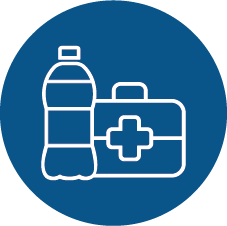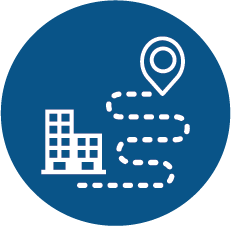- 06/16:12 EST Flood Warning Summary for Queensland
- 06/15:52 EST Marine Wind Warning Summary for Queensland
- 06/13:59 EST Moderate Flood Warning for the Eyre Creek
How to use Nextdoor during a disaster
Below are tips on using Nextdoor to share and find local information and resources to ask for or offer to help. When looking for and sharing information on Nextdoor, search for and include commonly used terms such as evacuation orders, road closures, supplies, petrol, and shelter.
- For the best experience, use the Nextdoor app or install it if it is not on your phone.
- To find trusted information from public agencies, go to https://nextdoor.com.au/agency/feed.
- Remember that some of your neighbours may need help. You can help them prepare, for example, by running errands, securing outdoor items, clearing drains, filling and placing sandbags.
- If evacuation orders are given, some of your neighbours may also need a ride; post on Nextdoor or knock on their doors with your offer.
- You may return home before others, and you can offer to check on your neighbours’ homes and take pictures of the damage so they can start the claim process.
- Repost messages you find helpful to increase visibility.
- Invite your neighbours to join Nextdoor to create more resilient neighbourhoods in times of crisis.
To ensure that you and your neighbours can communicate with each other to share vital information, give and get help, and receive essential updates from public agencies, join Nextdoor now!
Neighbour Stories
How to Prepare

Sign up for alerts and stay weather-aware:
- Check or join Nextdoor to get updates and alerts about your neighbourhood from local public agencies.
- Purchase or replace batteries for your NOAA weather radio.
- Check your local council’s website to see if they offer an emergency notifications system and sign up for alerts.
- Check the Bureau of Meteorology website or app and listen to your local radio station for severe weather warnings and updates: http://www.bom.gov.au/knowyourweather.
- Download The Emergency+ app a free app developed by Australia’s emergency services which uses GPS functionality built into smart phones to help a Triple Zero (000) caller provide critical location details required to mobilise emergency services.
Assemble or update supplies for your home, vehicle, pets, and children:
- Purchase non-perishable foods for each person to last at least three days.
- Ensure everyone has the medications they need and keep copies of prescriptions.
- Make sure you have food, water, and medications for pets.
- Put spare warm clothing in plastic bags and keep it handy.
- Fill your tub with water to boil for drinking or to flush the toilet if the water supply is interrupted.
- Withdraw cash as ATMs will not work during power outages.


Document and insure home and vehicles:
- Take photos of your possessions or store digital copies of important documents in the cloud (furniture, electronics, heating and cooling systems, valuables, etc.)
- Check your insurance declarations and talk with your agent about your needs each year.
- Consider getting flood insurance for your home, as homeowners insurance typically does not cover flooding.
Insurance resources:
- The Insurance Australia Group (IAG) provides a series of severe weather factsheets.
- The Insurance Council of Australia, has information on natural disasters and a hotline. Call 1800 734 621 (note this is not a claim lodgement service).
- The Insurance Law Service is an insurance helpline for consumers. Call the Insurance Hotline on 1300 663 464 Monday to Friday, 10am to 1pm.
Know your evacuation zone and routes and make a plan:
- If you live in low-lying areas susceptible to flooding and storms, learn in which evacuation zone you live should an evacuation order be issued.
- Identify several ways to evacuate your neighborhood and town/city.
- Post to Nextdoor and/or knock on doors to ask for help or identify nearby neighbors who need help evacuating in an emergency and make an agreement with them to help or be helped. Be sure to exchange contact information.


Create your family/household communication plan:
- Ensure everyone in your family/household has each other’s phone numbers saved in their phones.
- Determine a meeting point.
- Texting is best during emergencies, as phone lines may be tied up.
- If you’ve been displaced, register your details so your friends and family know you’re safe. The Red Cross’ Register.Find.Reunite website is a national system used to find and reunite loved ones after an emergency.
Plan with your neighbours:
Before disasters
- Post to Nextdoor to ask for and offer help to prepare for disasters, help with sandbags, secure or store outdoor items, etc.
- Park vehicles under shelter or cover with firmly tied tarpaulins/blankets.
- Shelter and secure pets and animals.
After disasters
- Post to Nextdoor to ask for and offer help taking pictures of damaged property so neighbours who have yet to return can submit insurance claims.
- Use Nextdoor to coordinate clean-ups, offer shelter, share or make a meal, or simply offer support to a neighbour.

Plan and Prepare
Weather warnings:
- Stay inside and shelter well clear of windows, doors and skylights.
- Don’t use a fixed telephone during a thunderstorm due to lightning danger.
- Avoid touching brick or concrete, or standing bare-footed on concrete or tiled floors.
- Keep checking the Bureau of Meteorology website or app and listen to your local radio station for storm warnings and updates.
- Where to get more information – Bureau of Meteorology pre-recorded telephone messages:
- ACT/New South Wales Coastal, Land Weather and Flood Warnings: 1300 659 218
- Victoria Coastal, Land Weather and Flood Warnings: 1300 659 217
- Queensland Land Weather and Flood Warnings: 1300 659 219
- Western Australia Land Weather and Flood Warnings: 1300 659 213
- South Australia Coastal, Land Weather and Flood Warnings: 1300 659 215
- Tasmania Coastal, Land Weather and Flood Warnings: 1300 659 216
- Northern Territory Coastal and Land Weather Warnings: 1300 659 214
Bushfires – Get Busfire Ready, make a fire plan
Resources are available at:
- NSW: Plan and prepare
- VIC: Plan and prepare for fire
- QLD: Make your bushfire survival plan
- WA: How fireproof is your plan?
- ACT: Bushfire ready
- SA: Bushfire survival plan
- TAS: Bushfire survival plan
- NT: Preparing for brushfires and your responsibility
Thunderstorms:
Floods:
Evacuation
- For latest evacuation warnings and information, visit your State and territory emergency services:
- The NSW State Emergency Service has prepared factsheets on what to do when an Evacuation Warning or an Evacuation Order is issued.
Red Cross Register.Find.Reunite: If you are displaced from your home, it’s important to register your details so your friends and family know you’re safe. The Register.Find.Reunite website is a national system used to find and reunite loved ones after an emergency.
Tips for returning home and cleaning up after a disaster
First off, please only return home when officials say it is safe to do so.
Do not enter your damaged home if:
🚨 Authorities have not declared it safe to return or enter
⛽️ You smell gas or hear a hissing sound (call 000)
🌊 Floodwaters remain around the building
Also, watch out for these fire hazards:
✔️ Appliances or vehicles exposed to water
✔️ Exposed power lines, electrical outlets & wiring
If there is damage to your home or belongings, document it before you clean it up:
📸 Take photos before you begin to clean up.
📝 Make a list of damaged or lost items & gather receipts.
⚡ Do not touch or cut power lines as they may be live
When cleaning, please follow these safety tips to stay safe.
1. Get the right safety gear:
- Hard hats
- Goggles
- N95 masks (or a respirator with a higher protection level)
- Earplugs or protective headphones (if you’re working with noisy equipment)
- At least two fire extinguishers
2. If sewage is involved, make sure to wear the following during your cleanup:
- Rubber boots
- Rubber gloves
- Goggles
3. Use teams to move heavy, or bulky objects:
- Have teams of at least two people work together to move heavy or bulky objects.
- Avoid lifting any material that weighs more than 22kg (per person).
4. Stay safe in hot weather:
- In hot weather, try to stay cool by staying in air-conditioned buildings, taking breaks in shaded areas or cool rooms, drinking water and nonalcoholic fluids often, and wearing light and loose-fitting clothing.
- Do outdoor activities during cooler hours.
- The Red Cross provides general advice about preparing for heatwaves.
- Local State and Territory related health tips is available at:
Cleaning up after a disaster
- Cleaning up debris and waste: Local councils can help residents dispose of flood-damaged rubbish and other waste. Some waste levies can be waived for waste arising as a result of storms and floods subject to a natural disaster declaration. Check your local landfill websites for opening hours and whether there are special requirements for disposing of flood-damaged waste.
- The Asbestos Awareness website has information on managing asbestos hazards following storms and floods.
- Your State Emergency Service (SES) created an SES Recovery guide from floods and storms . See more information from the SES below:
- Australian Red Cross provides advice and resources on Cleaning up after a disaster.
- State specific info e.g.
NSW: Flood clean-up assistance and advice
WA: Recovering after the flood – clean-up for householders
- State specific info e.g.
- The Australian Institute for Disaster Resilience’s (AIDR’s) Flood recovery resources page brings together a comprehensive collection of key guidance material, research, information, and useful tools to support communities recovering from major flooding events.
More resources
SUPPORT FOR COMMUNITY
- Emergency support volunteering – https://emergency.volunteer.org.au
- Donating blood – https://www.lifeblood.com.au/blood
Mental health support
- Lifeline 13 11 14, is available to listen and support 24 hours a day 7 days a week. Phone, SMS and online chat is available.
- Beyond Blue has developed an online resource on looking after your mental health after a disaster.
- Australian Red Cross provides resources on looking after yourself after a disaster.
- Headspace provides information for family and friends supporting young people affected by a natural disaster.
- Emerging Minds provides resources and advice on supporting children’s mental health during disaster and traumatic events.
Pets and wildlife
- Contact RSPCA for assistance with pets, livestock (including horses), and wildlife on 1300 278 358.
- If you have found a sick, injured or orphaned native animal read WIRES’ emergency rescue advice, and call WIRES’ Wildlife Rescue Office on 1300 094 737 or report the rescue online to access rescue advice and assistance 24/7.
Advice for Tenants
- Renters have rights if their home is damaged by disaster. The Tenants Union has advice on disaster damage for renters and answers to common questions on Renting After a Disaster. Enter your postcode here to find your local Tenants’ Advice & Advocacy Service. Or contact the Tenants Advice Line: 1800 251 101, on Mondays 10am-1pm and Thursdays 2-5pm.
Mobiles and utilities
- Telstra customers impacted by floods may be eligible for relief packages which can include one-off credit, mobile call diversion, a boost to data and free calls as well as reconnection support.
- Information for Optus customers impacted by floods.
- There are payment options and financial hardship options are also available for Simply Energy customers impacted by disasters. Call 13 88 08 (Monday-Friday, 8am-7pm) for assistance.
- Origin Energy can provide updates and additional bill relief for customers who have been severely impacted.
Visit the Australian Energy Regulator website to find out your gas or electricity provider.
Connect on Nextdoor
Sharing updates and resources with your fellow neighbours is a quick way to give and get help.



